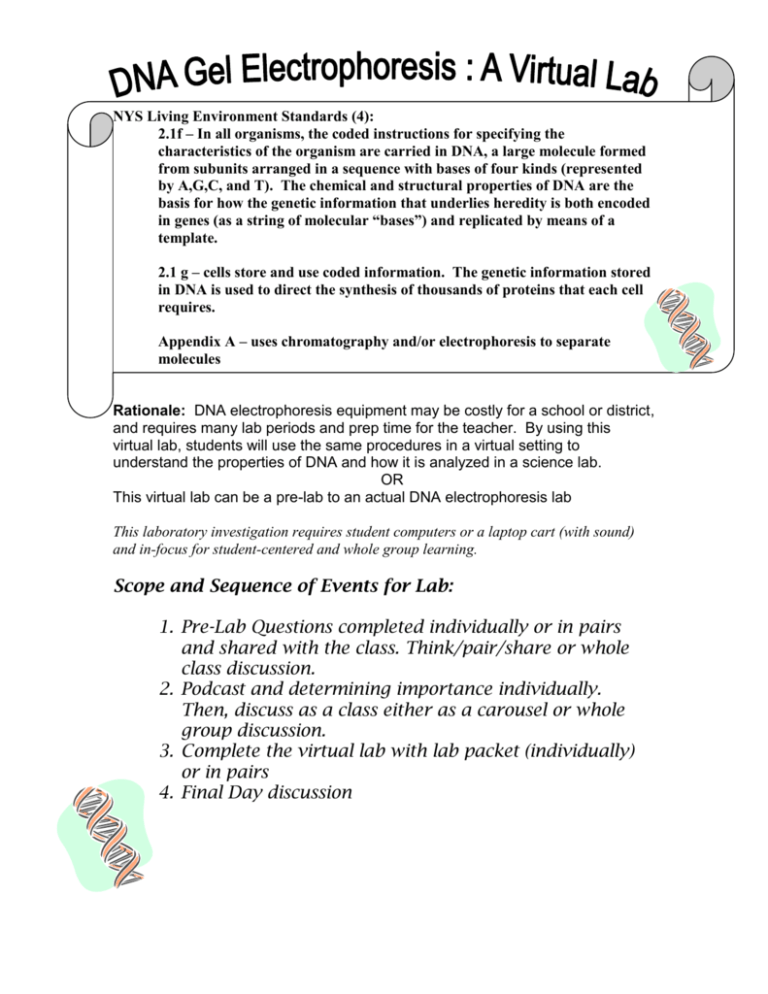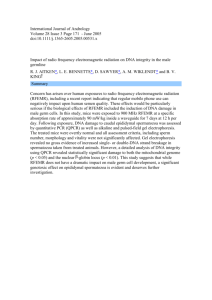DNA: A Crime Scene Investigation Virtual Lab
advertisement

NYS Living Environment Standards (4): 2.1f – In all organisms, the coded instructions for specifying the characteristics of the organism are carried in DNA, a large molecule formed from subunits arranged in a sequence with bases of four kinds (represented by A,G,C, and T). The chemical and structural properties of DNA are the basis for how the genetic information that underlies heredity is both encoded in genes (as a string of molecular “bases”) and replicated by means of a template. 2.1 g – cells store and use coded information. The genetic information stored in DNA is used to direct the synthesis of thousands of proteins that each cell requires. Appendix A – uses chromatography and/or electrophoresis to separate molecules Rationale: DNA electrophoresis equipment may be costly for a school or district, and requires many lab periods and prep time for the teacher. By using this virtual lab, students will use the same procedures in a virtual setting to understand the properties of DNA and how it is analyzed in a science lab. OR This virtual lab can be a pre-lab to an actual DNA electrophoresis lab This laboratory investigation requires student computers or a laptop cart (with sound) and in-focus for student-centered and whole group learning. Scope and Sequence of Events for Lab: 1. Pre-Lab Questions completed individually or in pairs and shared with the class. Think/pair/share or whole class discussion. 2. Podcast and determining importance individually. Then, discuss as a class either as a carousel or whole group discussion. 3. Complete the virtual lab with lab packet (individually) or in pairs 4. Final Day discussion PRE-LAB QUESTIONS 1. What is DNA? 2. How does DNA make each of us unique? 3. Where can we find DNA? 4. What do you know about running DNA “fingerprints” from watching TV, the news, reading about it in the paper or on-line? Directions: Watch the podcast on DNA introduction. Fill in the table below as you watch and listen to the podcast. 1. Determining Importance (FACTS), Questioning, and Responding: F AC T QUESTION RESPONSE NOW IT’S TIME TO WORK ON THE VIRTUAL DNA GEL ELECTROPHORESIS LAB. YA-HOO!! Directions: go to http://learn.genetics.utah.edu/units/biotech/gel/. As you progress through this lab, it is important to read both above and below the pictures to get a grasp on WHAT you are doing and WHY you are doing it! If at any time you do not understand the “what and why,” you can always go backwards, look things up on the Internet, or ask for help. Follow the directions at the bottom of the picture and in the virtual lab itself. The forward and back buttons are below the green square. 1. Gel Electrophoresis – what is in this tube, and what are you going to do with it? 2. What is the gel used for and why? 3. Make an analogy of how the gel sorts the DNA to something you are familiar with. Explain in the box below. 4. Why do we need to stain the DNA? 5. Give another example of staining used in science and explain what stain is used and WHY: 6. Write down the materials and steps for running a gel, and give a BRIEF explanation/snapshot of what’s happening at each step. If it helps you to sketch it, please do so. 7. Why do we use a size standard? 8. What is the size of the DNA fragments you ran through the gel electrophoresis? 9. Please write down your conclusions on the “post-it note” below. Include what you’ve learned from this lab, any questions you still have, connections you’ve made, or comments you have.






